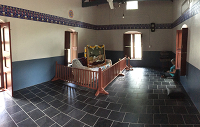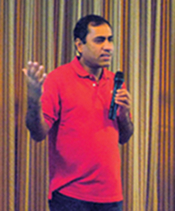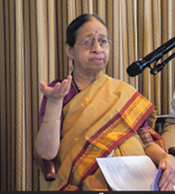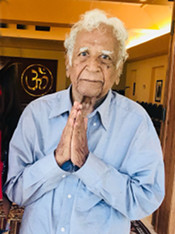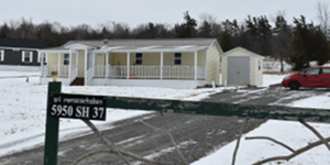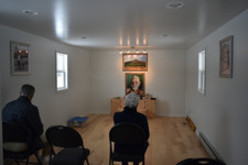Fifth Sri Ramana Jayanti Retreat, Tampa, FL
On Saturday, December 29, the annual Sri Ramana Jayanti Retreat began in the same place where it has for many of the devotees of Sri Ramana Maharshi for nearly a hundred years – in the presence of the Master, reclining on the sofa in the Old Hall. Though this Old Hall is not at the base of the Holy Arunachala Mountain in Tiruvannamalai, no one would have thought otherwise by looking around, sitting in the new replica Old Hall constructed by the devoted couple, Srimati Kalyanamathy and Dr. Rathinasamy, two years ago in Tampa.
There were 50 to 60 devotees gathered throughout the four-day retreat conducted both at the Old Hall (at 5919 Lynn Road) and at the Franciscan Retreat Center (at 3010 North Perry Ave.) in Tampa. These two settings are separated by a mere 20-minute drive.
The whole event was organized and executed by an inspired team of Florida devotees from the Tampa and Miami/ Ft. Lauderdale area Sri Ramana Satsang groups. Also, many participants happily volunteered their service which ensured what appeared as an effortless sequence of the program’s events.
On the first morning, at 11 A.M. in the Old Hall, the program began with the recitation of “Sri Arunachala Aksharamanamalai”, The Marital Garland of Letters. A series of four readings followed, interspersed with more recitations of the Maharshi’s works. The readings were culled from Paul Brunton’s A Search in Secret India, which graphically brings to life the presence of the Master, reclining on the couch, silently spreading his luster all around while the disciples (now the attendees of this retreat) sat quietly, meditating or yearningly gazing upon the gracious face of the sage who in his mercy bestowed and continues to bestow his grace upon earnest seekers of Truth.
After lunch at the nearby Hindu Temple of Tampa, a brief walk down the road, the devotees gathered in the temple shrine for the Sri Ramana Jayanti puja and abhishekam. The two-hour long ceremony passed like a flickering moment of time. Then, all drove back to the Franciscan Center for a period of free time in which we – children of our father Arunachala Ramana, both young and old – joined together like a family under His watchful eye.
Every morning from 5:00 to 7:30 and every evening between 7:30 and 9:00,[1] the devotees gathered in the Franciscan Center hall facing a majestically arranged altar adorned with photos of Bhagavan, Sri Arunachala and Sri Chakra. Flower garlands bedecked the pictures and the deepams and incense infused the room with holiness. It was here that the recitations, readings and silent meditations were conducted daily.
In this same hall three presentations were given by devotees who attended the retreat. All three presenters totally dedicated themselves to the subject of their presentations, which spontaneously flowed out of their hearts in streams of devotion.
On the morning of the second day of the retreat, Sunday, December 30th, Swaminathan Venkatramanan delighted us with his detailed description [2] of the life of Manikkavacakar and his divinely inspired poems, and described how the Maharshi would draw the attention of devotees to his monumental collection of songs, Tiruvachagam. Swaminathan also beautifully brought to our attention how Muruganar’s poetry was influenced by the great saint-poet and how Bhagavan guided Muruganar to emulate Manikkavacakar’s style of composing, even writing verses himself by way of encouragement.
On the same day, Srimati Mangalam, the sister of our President of Sri Ramanasramam, Sri V.S.Ramanan, graciously consented to present to the devotees a detailed description of the family lineages of Alagammal and Sundaram Iyer, Bhagavan’s mother and father. With the help of a digitally-produced graphic family tree created by her son, Sridhar Bharadwaj, Srimati Mangalam carefully explained the ancestry of family members who preceded Bhagavan’s parents, where they were born, whom they married, and so forth, along with Bhagavan’s siblings down to her generation. She had been working on this for some years; hence, we were prompted to request her to share what she had discovered. Srimati Mangalam patiently answered the earnest questions of devotees and concluded by describing to all the inspiration and guidance she has been blessed to receive from Bhagavan. In conclusion, Mangalam made it a point to mention that all of us are, indeed, the family of Bhagavan Ramana, and our relation with him is truly eternal and meaningful.
During periods of free time, some devotees would slip away from the retreat campus and drive back to the Old Hall to immerse themselves in the silence of its sublime atmosphere.
On Monday, besides the regular morning and evening chanting, readings and silent meditation, Dr.Saibish Kumar offered his presentation on the Kerala attendants of Bhagavan. A Keralite himself, he understood the geographical origins of these devotees. The inspiration and devotion that swept over him as he researched Pazhani Swami, Ayya Swami, Madhava Swami, Kunju Swami, Ramakrishna Swami and Satyananda Swami poured out to the attendees throughout his 90-minute presentation.[3]
A parallel Children’s Program was planned but only partially adopted because fewer children attended than anticipated. Nevertheless, the children did offer songs, dance and recitation of scriptures on Monday afternoon. Everyone was surprised by the professional quality of their offerings.
Again, on Monday, December 31st, after the nightly program that ended at 9 p.m., a screening of the newly re-mastered Sage of Arunachala documentary was viewed. Following a break, we watched the documentary containing interviews of senior devotees of Sri Bhagavan: Guru Ramana, His Living Presence. This brought us up to 11:30 P.M. on New Year’s Eve.
Unbeknownst to us, while immersed in watching the videos describing Bhagavan’s life and teachings, the children and some adult devotees were busy down by the Hillsborough River Franciscan Pavilion setting up a beautiful altar with flowers, rangoli, (floor designs) and lights for the midnight, New Year’s recitation of “Arunachala Aksharamanamalai”. The weather throughout the retreat was ideal, averaging 65 degrees at night and 80 during the day. And on New Year’s Eve night the sky was clear and temperature mild. As the devotees sat in a circle reciting the hymns to Arunachala that Bhagavan composed in his mercy for his devotees, across the river and all around you could feel the atmosphere alive with anticipation, marked by the crescendo of explosive fireworks growing louder, with fewer and fewer intervals, exploding in the sky with streaking, spectacular colors, reflecting magically in the sparkling waters before us.
“Arunachala Siva, Arunachala Siva, Arunachala Siva, Arunachala!” we chanted again and again in exhultation as the New Year exploded not only before our eyes but within our hearts. With what joyful devotion and gratitude we felt to have been guided by Him to gather together to begin another year, another day, another breath, in the overwhelming divine presence of our Master and Lord Arunachala Ramana.
Four Methods to Cessation of Thoughts
Mr.Cohen, a resident disciple, was speaking of yoga methods.
Maharshi remarked: Patanjali’s first sutra is applicable to all systems of yoga.
The aim is the cessation of mental activities. The methods differ.
So long as there is effort made towards that goal it is called yoga.
The effort is the yoga.
The cessation can be brought about in so many ways:
- By examining the mind itself.
When the mind is examined, its activities cease automatically.
This is the method of jnana. The pure mind is the Self. - Looking for the source of the mind is another method.
The source may be said to be God or Self or consciousness. - Concentrating upon one thought makes all other thoughts disappear.
Finally that thought also disappears; and - Hatha Yoga.
All methods are one and the same inasmuch as they all tend to the same goal.
It is necessary to be aware while controlling thoughts. Otherwise it will lead to sleep. That awareness, the chief factor, is indicated by the fact of Patanjali emphasizing pratyahara, dharana, dhyana, samadhi even after pranayama. Pranayama makes the mind steady and suppresses thoughts. Then why develop further? Because awareness then is the one necessary factor. Such states can be imitated by taking morphia, chloroform, etc. They do not lead to moksha because they lack awareness.
Comal Venkata Subramanian
For the last 20 years devotees of Arunachala Ashrama, New York and Nova Scotia, have greatly benefited from the unstoppable and irrepressible enthusiasm of Sri Comal Venkata Subramanian, or Comal Mama, as he was called by most of the devotees. In Milwaukee, Wisconsin, on Tuesday, December 4th, he breathed his last at the age of 96.
In 1940, at the age of 18 Comal had his first darshan of Bhagavan Sri Ramana Maharshi. He was then serving in the Indian Air Force, undergoing aviation training, when the battalion chief told him there was a need to serve in the ongoing World War. He immediately volunteered and was given a week leave prior to active duty. His mother, Mother Rajammal and Comal Circa 1940 Srimati Rajammal, a staunch devotee of Bhagavan, insisted that he should not proceed without the approval of Bhagavan. So, in January 1940 they both travelled to Tiruvannamalai.
On the second day of their visit to the Ashram, Rajammal told Bhagavan of Comal’s decision to join in the war and requested Bhagavan’s blessings and permission. Bhagavan did not respond but asked them both to please go take rest because they appeared tired. On the third day after broaching the same subject with Bhagavan, he told mother and son to please do the giripradakshina of Arunachala, which they immediately did. On the fourth day they had to leave and went to take Bhagavan’s blessings. Rajammal again mentioned about blessings and permission regarding her son’s participation in the war. Bhagavan, gave an effervescent smile, and said “Besha pannungo,” (of course; certainly do) basically giving Comal an unreserved go-ahead.
During the 1940’s Comal Mama was able to visit the Ashram on three more occasions. He closely observed Bhagavan, how he mixed with his animal friends and human devotees alike. In 1946 he was visiting the Ashram when Sri Dorab showed several movies to Bhagavan in the dining hall. Thanks to these experiences and observations that were indelibly imprinted upon his heart, along with the abundant flow of grace he received from Bhagavan throughout his life, Comal Mama never tired of regaling devotees with his stories. Bhagavan was ever-present with him throughout his long life and there is little doubt that after leaving his body behind, it continues even now.
The article,
“Bhagavan’s Ubiquitous Grace”, published in the October, 2004 edition of
'The Mountain Path' describes in detail Comal Subramanian's experiences.)
श्रीरमणाचल मन्दिरम्
Sri Ramanachala Mandiram in Ogdensburg, New York
For the last two years Sri Padmanabhan, of Ottawa, Canada, with the support of his devoted wife Srimati Madhu, has been relentlessly working to fulfill his childhood dream of constructing a shrine to Bhagavan Sri Ramana Maharshi. In April, 2019 he is planning to have the kumbhabhishekam of this shrine seen below (in the foreground). It picturesquely overlooks the St.Lawrence Seaway, on the New York State side of the river. Those interested in visiting should contact Padmanabhan at 315 212-9562 or email him at ogsRamanaAchalam @ gmail · com.
January 11, 1983
In my room this afternoon, Ramaswami spoke again of the greatness of Self-Enquiry. “There, you have so many activities (meaning me as an individual). That is why you do not rigorously practice Self-Enquiry. But once your activities are less, the method will come to you very naturally. At that time you will be surprised at how natural and effective it is, and you will regret that you didn’t take to it earlier.” These words were unsettling to me. “How can I most effectively practice Sri Bhagavan’s teaching?” I asked myself again and again. During meditation His Name quelled my thoughts and I felt at peace.
January 16, 1983
This morning the temple drummers woke me at 4 a.m. and when I realized that the images of Sri Arunachaleswara and his consort were coming around the hill I quickly jumped into slacks and shawl and ran up to the road. The images wended their way through pitch blackness, illumined only by bright torches and accompanied by horn and drums. At the Ashram, offerings were made and, during the arati before the Ashram gate, I took a photo. This caught the eye of a man nearer to the offering plate than I. He motioned for the priest to come to me; he gave me the vibhuti which I received with reverence. I remembered how Bhagavan, on such an occasion, remarked, “The son is beholden to the Father,” and I felt that somehow Sri Arunachaleswara, the Father, knowing my extreme need of His grace, singled me out among the hundred or so people at the roadside to receive the sacred ash.
Paul and I recorded the Vedic recitations of Kittu and Appichi in Paul’s room. After the taping was finished, we presented them with letters of appreciation and gifts. We read out our letters to them which described the inspiration we gain by listening to their recitation of the Vedas and the Sri Chakra Puja year after year, and how we derive from them the inspiration to carry on our lives in Sri Bhagavan’s Name. Kittu spoke with such humility and sincerity: “Here we are very gratified and happy that you listen to and appreciate the Vedic recitations. There are so many here, so many sit quietly, yet we find no one who does the practice as all of you do from Arunachala Ashrama.”
Kittu described how he and Appichi were boys in the first Veda Patasala founded by Major Chadwick. They would recite before Bhagavan in the Old Hall in the mornings at 5 a.m. and again in the afternoon. During the day, Bhagavan would walk out toward the goshala and the Veda Patasala and inquire after their welfare. Thus they received his grace in a personal way. When Kittu saw we had presented him with a dhoti he reminisced how each year Major Chadwick would present all the boys in the school with fresh clothes.
Appichi wished to hear us recite a few names of “Sri Lalitasahasranam.” Paul and I happily obliged.
Kittu and Appichi took our leave. As they slowly walked, side by side, across the yard in front of the Old Hall I followed their path intently with my eyes and wished to always remember the image of these two humble, lifelong servants of Bhagavan.
Around 6 p.m Kunju Swami and Natesan came to Muruganar’s room to recite “Sri Arunachala Akshara Mana Malai.” Kunju Swami then spoke movingly of Bhagavan and His relation with Sri Arunachala: “‘Arunachala, Arunachala’ repeated within Bhagavan’s mind from his youth. He wrote, ‘From the age of innocence it had shone within my mind that Arunachala was something of surpassing grandeur.’ Sri Bhagavan’s Arunachala-sphurana was the cause of his seeming absent mindedness at school. Sri Arunachala, within, was pulling his mind to the center. People say that Bhagavan had no teacher, but he himself has written, ‘Making me free from faults and endowing me with virtues, accept me as Thy devotee, O Arunachala, that shinest as the Guru!’ Normally, when a person receives a pencil or pen he will first write his own name. Bhagavan, however, would always write ‘Arunachala’-Arunachala was his Name! Arunachala is none other than the Supreme Self. “This He proclaims in ‘Sri Arunachala Pancaratnam’ and again in ‘Navamanimalai’ verse 1: ‘Although Siva is motionless, He dances before the Mother (Shakti) who stands still in the Court of Chidambaram. But know that that Shakti is withdrawn into His unmoving Self and He stands in His randeur as the towering Arunachala.’ And in stanza 2,
‘When one inquires into the meaning of Arunachala which is lustrous like red gold and bestows liberation, one finds that the word ‘Aruna’ means Sat, Chit and Ananda (existence, consciousness and bliss).’”
Letters and Comments
Sixth Sense Required ?
A quote from another master (Nisargadatta Maharaj) seems congruent with Ramana’s teaching and frames the background to my question perfectly:
You cannot meaningfully say ‘this is what I am’. It just makes no sense. What you can point out as ‘this’ or ‘that’ cannot be yourself. Surely, you cannot be ‘something’ else. You are nothing perceivable, or imaginable. Yet, without you there can be neither perception nor imagination ...”.
The sentences bolded are the essential ones. They seem to make perfect sense.
But do they not imply “Reality” is beyond our power to perceive?
Granted “Reality” must exist (“Yet, without you there can be neither perception nor imagination ...”) but either it is something we can only infer (and what use is logical inference—being entirely conceptual it doesn’t satisfy) or, given that “knowledge” necessarily involves the dichotomy of subject-object, we would indeed need to grow a new faculty of “unitary perception” to be able to grasp it — and evidence of such a faculty is nowhere to be seen.
There seems to be no way out: Reality appears to be beyond us “forever”!
What (further) might the Maharshi have said?
It is true that the “Reality is beyond us, forever”. It is the ‘us’ in us that makes it so. If we eliminate the ‘me’ there will be no perceived ‘we’, no ‘us’, just the Being, the True Self, the one Reality.
Bhagavan has given a clear, direct method to experience who we really are, our true nature which is eternal, ever-present, but obscured by one little speck of dust in our eye, so to speak, and that is the ego. When it is washed out or worn down to nothing and eliminated, the Self, our true Self alone shines eternally.
In the last sentence of your question you wrote: “What (further) might the Maharshi have said?”
To the earnest aspirant who approached him for solutions to their doubts, he was invariably responsive. But more often the doubts simply dissolved in his presence and not a word was spoken, for peace and clarity filled the seeker’s heart and mind. I believe that this same process continues even now at Sri Ramanasramam, or wherever his presence is invoked with genuine sincerity and devotion.
But what would the Maharshi have said? Perhaps something along these lines:
If by ‘our’ in your question, you mean the ego, the Maharshi might have said, Yes, definitely, the ego is incapable of perceiving the Reality, simply because what we are in reality is beyond the mind and senses and is egoless. For the true Self there is no other, no second to perceive, it is beyond the subject and object, beyond the ego.
The Self is the foundation on which everything exists, including the ego who perceives and imagines, and although inference or conceptualization of the Truth may not be the Truth, nevertheless clear intellectual understanding is a pathway which ends in the realization of the Truth.
No additional faculty is required to know the Self. Do you need a mirror to know that you exist? Existence is Being, Consciousness. Now our consciousness perceives existence only in relation to thoughts. Remove the thoughts and hold the Being alone, then our true essential nature is revealed.
This is how it is. As individuals we can never really experience it,
but the truth is and “You are That”.
Teachings on Display
This was posted behind the desk of
the woman who assisted Anna and me
at the local Social Security office this week.
I’m sure Bhagavan would approve...
:)
[1] The Retreat program is available as a
![]()
[2] the notes that go with Swami's slides are also available
[3] The presentations of this year‘s retreat together with those of previous years will soon be uploaded to the Arunachala Ashrama YouTube channel.
[4] view the collated articles



